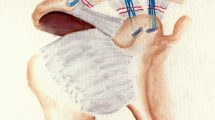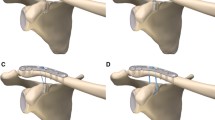Abstract
Purpose
Recently, many acromioclavicular–coracoclavicular (AC–CC) ligament reconstruction techniques address only the CC ligament. However, many of these techniques are costly, time-consuming, and require the use of allogenic grafts, making them prone to creep and failure or novel devices making them challenging for orthopaedic surgeons. The purpose of this study was to compare the biomechanical characteristics of a double endobutton technique using a standard endobutton CL with those of a coracoid cerclage sling (CS) for reconstruction of the CC ligaments.
Methods
Anterior–posterior (AP) translation and superior–inferior (SI) translation were quantified for eight matched pairs of intact AC joints. One shoulder from each pair underwent a double endobutton repair, using an endobutton CL modified with an additional endobutton (Smith & Nephew, Memphis, Tenn) and placed through holes in the coracoid and clavicle. The contra-lateral shoulder received a coracoid sling reconstruction using an anterior tibialis tendon. Translation testing was repeated after reconstruction, followed by load-to-failure testing. Paired t tests were used for statistical analysis.
Results
The CS technique demonstrated a greater SI and AP translation than the double endobutton technique (p < 0.05). Additionally, the double endobutton technique had a greater stiffness (40.2 ± 11.0 vs. 20.3 ± 6.4 N/mm, p = 0.005), yield load (168.5 ± 11.0 vs. 86.8 ± 22.9 N, p = 0.002), and ultimate load (504.4 ± 199.7 vs. 213.2 ± 103.4 N, p = 0.026) when compared to the CS technique.
Conclusion
The double endobutton technique yielded less translation about the AC joint and displayed stronger load-to-failure characteristics than the CS reconstruction. As such, this technique may be better suited to restore native AC–CC biomechanics, reduce post-operative pain, and prevent recurrent subluxation and dislocation than an allogenic graft construct. The double endobutton technique may be a suitable option for addressing AC–CC injuries.





Similar content being viewed by others
References
Beitzel K, Obopilwe E, Chowaniec D, Niver G, Nowak M, Hanypsiak B, Guerra J, Arciero R, Mazzocca A (2011) Biomechanical comparison of arthroscopic repairs for acromioclavicular joint instability: suture button systems without biological augmentation. Am J Sports Med 39(10):2218–2225
Breslow M, Jazrawi L, Bernstein A, Kummer F, Rokito A (2002) Treatment of acromioclavicular joint separation: suture or suture anchors? J Shoulder Elb Surg 11(3):225–229
Choi S, Lee T, Moon K, Cho K, Lee S (2008) Minimally invasive coracoclavicular stabilization with suture anchors for acute acromioclavicular dislocation. Am J Sports Med 36(5):961–965
Costic R, Labriola J, Rodosky M, Debski R (2004) Biomechanical rationale for development of anatomical reconstructions of coracoclavicular ligaments after complete acromioclavicular joint dislocations. Am J Sports Med 32(8):1929–1936
Deshmukh A, Wilson D, Zilberfarb J, Perlmutter G (2004) Stability of acromioclavicular joint reconstruction: biomechanical testing of various surgical techniques in a cadaveric model. Am J Sports Med 32(6):1492–1498
Dimakopoulos P, Panagopoulos A, Syggelos S, Panagiotopoulos E, Lambiris E (2006) Double-loop suture repair for acute acromioclavicular joint disruption. Am J Sports Med 34(7):1112–1119
Gerhardt C, Kraus N, Pauly S, Scheibel M (2013) Arthroscopically assisted stabilization of acute injury to the acromioclavicular joint with the double TightRope™ technique: one-year results. Der Unfallchirurg 116(2):125–130
Grutter P, Petersen S (2005) Anatomical acromioclavicular ligament reconstruction: a biomechanical comparison of reconstructive techniques of the acromioclavicular joint. Am J Sports Med 33(11):1723–1728
Harris R, Wallace A, Harper G, Goldberg J, Sonnabend D, Walsh W (2000) Structural properties of the intact and the reconstructed coracoclavicular ligament complex. Am J Sports Med 28(1):103–108
Huang T-W, Hsieh P-H, Huang K-C, Huang K-C (2009) Suspension suture augmentation for repair of coracoclavicular ligament disruptions. Clin Orthop Relat Res 467(8):2142–2148
Kousa P, Järvinen T, Vihavainen M, Kannus P, Järvinen M (2003) The fixation strength of six hamstring tendon graft fixation devices in anterior cruciate ligament reconstruction. Part II: tibial site. Am J Sports Med 31(2):182–188
Lim Y (2008) Triple endobutton technique in acromioclavicular joint reduction and reconstruction. Ann Acad Med Singap 37(4):294–299
Lizaur A, Marco L, Cebrian R (1994) Acute dislocation of the acromioclavicular joint. Traumatic anatomy and the importance of deltoid and trapezius. J Bone Joint Surg Br 76(4):602–606
Mazzocca A, Santangelo S, Johnson S, Rios C, Dumonski M, Arciero R (2006) A biomechanical evaluation of an anatomical coracoclavicular ligament reconstruction. Am J Sports Med 34(2):236–246
Motamedi A, Blevins F, Willis M, McNally T, Shahinpoor M (2000) Biomechanics of the coracoclavicular ligament complex and augmentations used in its repair and reconstruction. Am J Sports Med 28(3):380–384
Oh Y, Namkoong S, Strauss E, Ishak C, Hecker A, Jazrawi L, Rosen J (2006) Hybrid femoral fixation of soft-tissue grafts in anterior cruciate ligament reconstruction using the endobutton CL and bioabsorbable interference screws: a biomechanical study. Arthroscopy 22(11):1218–1224
Salzmann G, Walz L, Buchmann S, Glabgly P, Venjakob A, Imhoff A (2010) Arthroscopically assisted 2-bundle anatomical reduction of acute acromioclavicular joint separations. Am J Sports Med 38(6):1179–1187
Salzmann G, Walz L, Schoettle P, Imhoff A (2008) Arthroscopic anatomical reconstruction of the acromioclavicular joint. Acta Orthop Belg 74(3):397–400
Schliemann B, Lenschow S, Schürmann P, Schroeglmann M, Herbort M, Kösters C, Raschke M (2013) Biomechanics of a new technique for minimal-invasive coracoclavicular ligament reconstruction. Knee Surg Sports Traumatol Arthrosc 21(5):1176–1182
Shin S-J, Yun Y-H, Yoo J (2009) Coracoclavicular ligament reconstruction for acromioclavicular dislocation using 2 suture anchors and coracoacromial ligament transfer. Am J Sports Med 37(2):346–351
Struhl S (2007) Double endobutton technique for repair of complete acromioclavicular joint dislocations. Tech Shoulder Elb Surg 8(4):175–179
Thomas K, Litsky A, Jones G, Bishop J (2011) Biomechanical comparison of coracoclavicular reconstructive techniques. Am J Sports Med 39(4):804–810
Walz L, Salzmann G, Fabbro T, Eichhorn S, Imhoff A (2008) The anatomic reconstruction of acromioclavicular joint dislocations using 2 TightRope devices: a biomechanical study. Am J Sports Med 36(12):2398–2406
Wei H-F, Chen Y-F, Zeng B-F, Zhang C-Q, Chai Y-M, Wang H-M, Lu Y (2011) Triple endobutton technique for the treatment of acute complete acromioclavicular joint dislocations: preliminary results. Int Orthop 35(4):555–559
Zhao L-l, Zhang Y-n, Xue Q-y, Yin Z-l, Shi L, Wang L, Huang G-y (2011) Comparative analysis of modified Dewar method versus arthroscopic double Endobutton fixation technique for the treatment of acute acromioclavicular joint dislocation. Zhonghua yi xue za zhi 91(23):1587–1590
Zhu J, Liu F, Zhang J, Dong Q, Li S, De S (2012) Triple endobutton technique for repair of chronic complete acromioclavicular joint dislocations. Zhongguo xiu fu chong jian wai ke za zhi= Zhongguo xiufu chongjian waike zazhi= Chin J Reparative Reconstr Surg 26(2):201–204
Zhu R-T, Ying Y-R, Gao F-M, Wang B, Chen M, Ying G-H, Zhang D-Q, Ma Y (2009) Clinical study on the treatment of acromioclavicular joint dislocation of Tossy grade III with double endobutton. Zhongguo gu shang = China J Orthop Traumatol 22(9):653–654
Acknowledgments
The institution of one or more authors has received funding for this study by a grant from VA Rehabilitation Research and Development Merit Review.
Author information
Authors and Affiliations
Corresponding author
Rights and permissions
About this article
Cite this article
Grantham, C., Heckmann, N., Wang, L. et al. A biomechanical assessment of a novel double endobutton technique versus a coracoid cerclage sling for acromioclavicular and coracoclavicular injuries. Knee Surg Sports Traumatol Arthrosc 24, 1918–1924 (2016). https://doi.org/10.1007/s00167-014-3198-8
Received:
Accepted:
Published:
Issue Date:
DOI: https://doi.org/10.1007/s00167-014-3198-8




